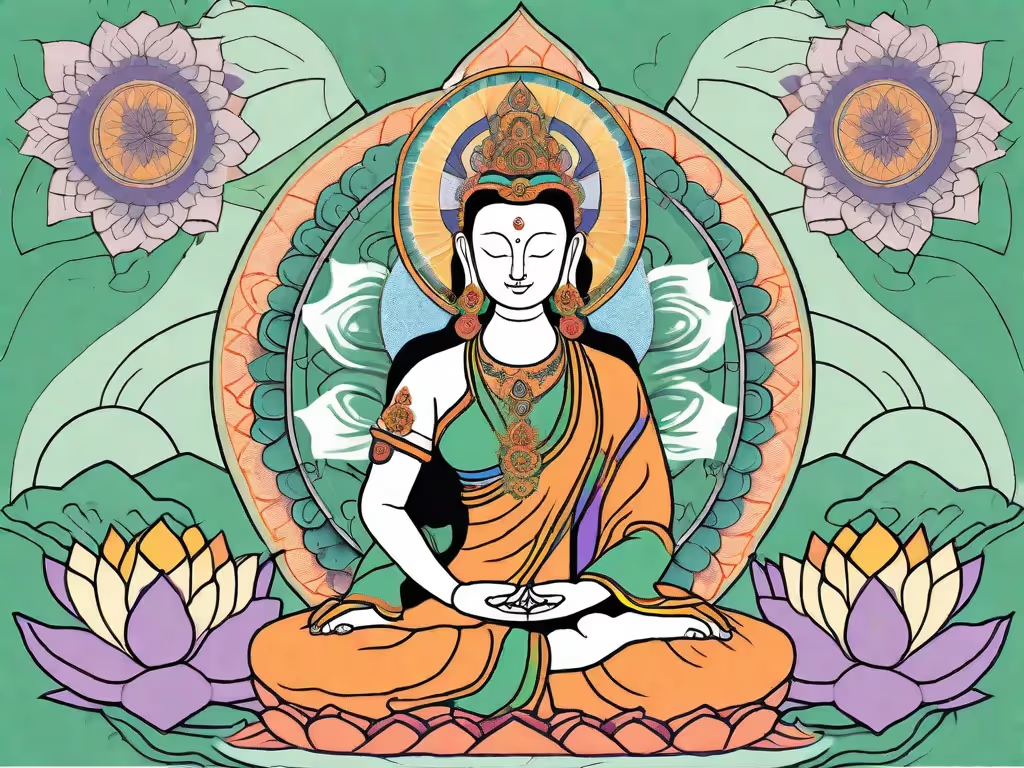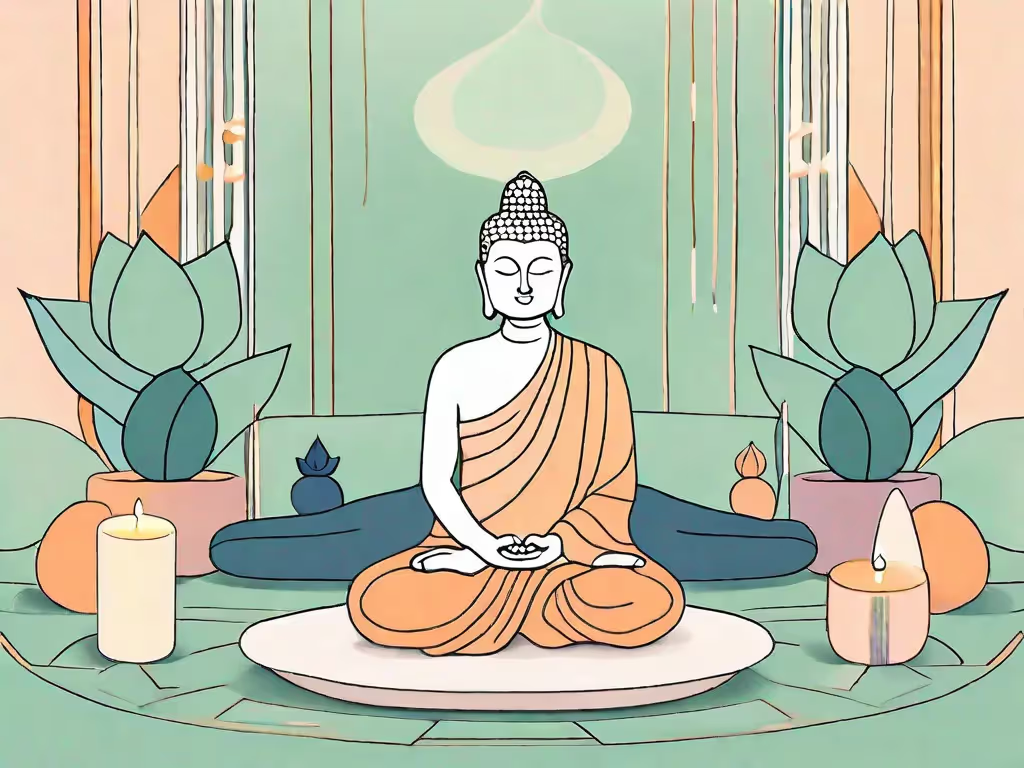Tibetan White Tara Meditation is a profound spiritual practice that offers a gateway to inner peace, compassion, and longevity. This ancient meditation technique revolves around the worship of White Tara, a female deity associated with compassion and healing in Tibetan Buddhism. By understanding the significance of White Tara and immersing ourselves in her teachings, we can unlock deep spiritual insights and cultivate a more enlightened way of living.
Understanding the Tibetan White Tara
White Tara, also known as "Sitatara" or "Drolkar," is revered as a manifestation of Tara, the female Bodhisattva of compassion. In Tibetan Buddhism, Tara is one of the central figures, embodying the feminine aspect of enlightenment. White Tara, specifically, is associated with purity, healing, and longevity.
Legend has it that White Tara was born from a tear shed by Avalokiteshvara, the Bodhisattva of compassion, as he observed the suffering of sentient beings. As the tear fell to the ground, it transformed into a beautiful white lotus, and White Tara emerged from its petals. She is often depicted seated on a lotus flower, symbolizing her purity and connection to the divine.
The Significance of White Tara in Tibetan Buddhism
White Tara holds immense importance in Tibetan Buddhism, where she is regarded as a compassionate mother figure who guides individuals towards liberation from suffering. Her practice is believed to bestow inner strength, clarity, and protection, helping practitioners overcome obstacles and attain spiritual awakening.
Devotees of White Tara believe that by invoking her presence and reciting her mantra, they can receive her blessings and experience profound healing. She is known for her ability to alleviate physical, emotional, and spiritual ailments, offering solace and comfort to those in need. Her compassionate nature extends to all beings, regardless of their background or beliefs.
The Symbolism of White Tara's Iconography
White Tara is often depicted seated on a lotus flower, symbolizing purity. Her seven eyes, including the ones on her forehead, palms, and soles, represent her ability to perceive the suffering in the world and extend her compassion to all beings. These eyes also symbolize her omniscience, as she sees and understands the past, present, and future.
Her peaceful expression and graceful posture encompass the qualities of inner tranquility and wisdom. The serene smile on her face emanates a sense of calm and reassurance, reminding practitioners that they are not alone in their struggles. White Tara's right hand is extended in the gesture of granting boons, while her left hand holds a white lotus, symbolizing purity and spiritual awakening.
White Tara's mantra, "Om Tare Tuttare Ture Mama Ayuh Punya Jñana Pustim Kuru Svaha," is chanted by devotees as a means of invoking her blessings and protection. The repetition of this mantra is believed to bring about positive transformation, purify negative karma, and grant longevity.
As a revered figure in Tibetan Buddhism, White Tara continues to inspire and guide practitioners on their spiritual journey. Her compassionate presence serves as a reminder of the innate potential for enlightenment within all beings, encouraging individuals to cultivate kindness, compassion, and wisdom in their lives.
The Philosophy Behind White Tara Meditation
White Tara Meditation is grounded in profound philosophical concepts that shape our understanding of compassion and mindfulness. It is a practice that goes beyond the surface level, delving into the depths of our being to cultivate a profound sense of empathy and inner peace.
The Concept of Compassion and Longevity
Compassion lies at the heart of Tibetan Buddhism, and White Tara Meditation emphasizes the cultivation of compassion towards oneself and others. It is a practice that encourages us to open our hearts and minds to the suffering of others, recognizing that we are all interconnected in this vast web of existence.
Through the practice of White Tara Meditation, we learn to embrace our vulnerabilities, acknowledging that it is through our own experiences of pain and suffering that we can truly understand and empathize with the struggles of others. This compassionate outlook extends beyond mere sympathy; it is a deep and genuine understanding of the human condition.
Furthermore, White Tara Meditation promotes longevity, not only in terms of physical well-being but also in the context of spiritual growth and wisdom. By cultivating compassion and mindfulness, we nourish our inner selves, allowing us to flourish and thrive in all aspects of life. It is through this practice that we can tap into the wellspring of wisdom that resides within us, guiding us towards a life of purpose and fulfillment.
The Role of Mindfulness in White Tara Meditation
Mindfulness is a cornerstone of White Tara Meditation. It is the art of being fully present in the moment, without judgment or attachment. Through the practice of mindfulness, we learn to observe our thoughts and emotions with clarity and equanimity, cultivating a heightened awareness of the present moment.
White Tara Meditation teaches us to let go of the past and the future, anchoring ourselves in the here and now. By doing so, we dissolve distractions and cultivate a deep sense of inner peace. In this state of mindfulness, we become more attuned to the subtle nuances of our thoughts, emotions, and sensations, allowing us to respond to life's challenges with grace and wisdom.
Regular meditation practice trains our minds to become more focused, resilient, and in tune with the teachings of White Tara. It is through this practice that we can tap into the limitless potential of our minds, uncovering the profound truths that lie within us.
As we deepen our practice of White Tara Meditation, we embark on a transformative journey of self-discovery and self-transcendence. We learn to navigate the complexities of life with compassion and mindfulness, embracing the interconnectedness of all beings. Through this practice, we not only cultivate a deep sense of empathy and inner peace but also contribute to the well-being and happiness of the world around us.
The Process of White Tara Meditation
The practice of White Tara Meditation consists of various stages that guide us towards self-discovery and spiritual growth.
Preparing for the Meditation
Before diving into the meditation itself, it is essential to create a conducive environment for practice. Find a quiet and comfortable space where you can sit undisturbed. Settle into a relaxed posture and take a few moments to center yourself, focusing on your breath and setting your intention for the meditation.
The Stages of White Tara Meditation
White Tara Meditation typically involves visualizations, mantras, and breath-awareness techniques. As you settle into the practice, imagine yourself embodying the qualities of White Tara. Visualize her pure white light enfolding you, radiating love, compassion, and healing energy. Chanting the mantra "Om Tare Tuttare Ture Mama Ayuh Punya Jñana Pustim Kuru Svaha" further deepens the connection with White Tara's compassionate energy.
The Spiritual Insights from White Tara Meditation
Embarking on a journey with White Tara Meditation can lead to profound spiritual insights that can positively impact our daily lives.
Achieving Inner Peace and Tranquility
White Tara Meditation offers solace in the midst of our chaotic and fast-paced world. By cultivating mindfulness and compassion, we discover a newfound sense of inner peace and tranquility. Through regular practice, we learn to let go of reactivity and find serenity within ourselves, enabling us to approach life's challenges with equanimity.
Cultivating Compassion and Empathy
White Tara Meditation opens our hearts to the interconnectedness of all beings. By developing a deep sense of compassion and empathy, we can navigate the world with kindness, love, and understanding. This practice teaches us to see beyond ourselves and embrace the inherent worth and dignity of every living being, fostering a more harmonious society.
Integrating White Tara Meditation into Daily Life
To truly benefit from White Tara Meditation, it is essential to integrate the practice into our daily lives.
Practical Tips for Consistent Practice
Consistency is key when it comes to meditation. Set aside a specific time each day to dedicate to your practice. It doesn't have to be lengthy; even a few minutes can make a difference. Create a ritual around your meditation, whether it's lighting a candle or playing soothing music, to signal to your mind and body that it's time for stillness and introspection.
The Long-term Benefits of Regular Meditation
Regular White Tara Meditation can have far-reaching effects on our well-being and spiritual growth. Over time, we may experience improved focus, reduced stress, increased emotional resilience, and a deeper connection to our inner selves. The benefits extend beyond our meditation cushion, permeating into our relationships, work, and overall sense of purpose.
In conclusion, Tibetan White Tara Meditation serves as a doorway to spiritual insights and practices that can enrich our lives and transform our state of being. By embracing the teachings, symbolism, and philosophy of White Tara, we embark on a journey towards self-discovery, compassion, and enlightenment. Remember, the Aura Health App offers a wealth of resources and guided meditations to support you on your path to inner growth and well-being.
Aura is Your All In One App for Meditation, Mindfulness Wellbeing
Find peace every day with one app for your whole well-being. There is no one-size-fits-all solution to mental well-being. Aura is the first all-in-one wellness app that learns how to best help you. Discover an endless library of expert-created tracks for your well-being, all taught by the world’s best coaches, therapists, and storytellers. With Aura's personalized recommendations, you can find peace every morning, day and night.



.webp)






.avif)

%20(1).avif)


.avif)
.avif)
.webp)


.avif)


















































































































.avif)

















.svg)









